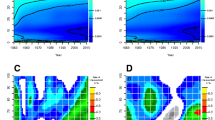Abstract
Techniques used in practice often differ from tools developed in academia. The lack of communication that may exist between academia and practice can then have important consequences for many insurance companies or pension funds. This issue is illustrated with what is currently happening in Switzerland. Swiss pension funds use mortality tables that are regularly updated with new observations. A new version of these tables has been recently published and includes a procedure to forecast mortality until 2150. The method applied for these projections is very different from the several forecasting models that have been developed in academia over the last decades. In this paper, we compare mortality forecasts used by practitioners in Switzerland and the forecasts resulting from two simple approaches well-known in academia, the Lee–Carter model and the Heligman–Pollard function. These two approaches have the advantage of simplicity and thus, all insurance companies and pension funds may implement them without any difficulties. The analysis demonstrates that both academic methods forecast a more important decrease in mortality than the approach applied by pension funds, especially in the long-run and for females. Impacts on pension liabilities are then evaluated, enlightening the future challenges many institutions will face. Finally, a few points which insurance companies or pension funds need to be cautious with, when using mortality forecasts, are summarized.









Similar content being viewed by others
Notes
A new version of these tables is expected for November 2011.
Terminology used by McNown and Rogers [14].
In order to avoid to overload the equations, the sex index is omitted.
The IAS19 requires to set assumptions on future mortality rates that should represent the “best estimates”. If the life expectancy is assumed to increase in the coming years, generation tables are perceived as "best estimates".
References
Bell WR (1997) Comparing and assessing time series methods for forecasting age-specific fertility and mortality rates. J Off Stat 13(3):279–303
The Department of Demography at the University of California, The Max Planck Institute for Demographic Research (2007) Human mortality database. http://www.mortality.org
Bongaarts J (2005) Long-range trends in adult mortality: models and projection methods. Demography 42(1):23–49
Booth H, Maindonald J, Smith L (2002) Applying Lee–Carter under conditions of variable mortality decline. Popul Stud 56(3):325–336
Booth H, Tickle L (2008) Mortality modelling and forecasting: a review of methods. Ann Actuar Sci 3:3–43
Coale A, Kisker E (1990) Defects in data on old age mortality in the United States: new procedures for calculating approximatively accurate mortality schedules and life tables at the highest ages. Asian Pac Popul Forum 4:1–31
Delwarde A, Denuit M (2006) Construction de Tables de Mortalité Périodiques et Prospectives. Economica, Paris
Felipe A, Guillen M, Perez-Marin AM (2002) Recent mortality trends in the Spanish population. Br Actuar J 8:757–786
Gaille S, Sherris M (2011) Modelling mortality with common stochastic long-run trends. Geneva Pap Risk Insur Issues Pract 36(4):595–621
Heligman L, Pollard JH (1980) The age pattern of mortality. J Inst Actuar 107:49–80
Lee RD (2000) The Lee–Carter method of forecasting mortality, with various extensions and applications. North Am Actuar J 4:80–93
Lee RD, Carter L (1992) Modeling and forecasting US mortality. J Am Stat Assoc 87:659–671
Lee RD, Miller T (2001) Evaluating the performance of the Lee–Carter approach to modeling and forecasting mortality. Demography 38:537–549
McNown R, Rogers A (1989) Forecasting mortality: a parameterized time series approach. Demography 26(4):645–660
McNown R, Rogers A (1992) Forecasting cause-specific mortality using time series methods. Int J Forecast 8:413–432
Menthonnex J (2006) Tables de mortalité longitudinales pour la Suisse. Technical Report, SCRIS
Menthonnex J (2009) La Mortalité par Génération en Suisse. Technical Report, SCRIS
Münz R, Wanner P (2006) Démographie: Ce qui Nous Attend Demain. Evolutions Globales, Tendances Européennes et Vieillissement en Suisse. Technical Report, Avenir Suisse
Pandit SM, Wu SM (2001) Time series and system analysis with applications. Krieger, Malabar
Rogers A, Gard K (1991) Applications of the Heligman/Pollard model mortality schedule. Popul Bull U N 30:79–105
Tabeau E, Ekamper P, Huisman C, Bosch A (1999) Improving overall mortality forecasts by analysing cause-of-death, period and cohort effects in trends. Eur J Popul 15(2):153–183
Tabeau E, Van Den Bergh Jeths A, Heathcote C (2001) Forecasting mortality in developed countries. Insights from a Statistical, Demographic and Epidemiological Perspective. Kluwer Academic Publishers, Dordrecht
Thiel PN (1872) On a mathematical formula to express the rate of mortality throughout the whole life. J Inst Actuar 16:313–329
Tuljapurkar S, Li N, Boe C (2000) A universal pattern of mortality decline in the G7 countries. Nature 405:789–792
Acknowledgments
The author acknowledges Corina Constantinescu for her precious and very useful comments on the paper.
Author information
Authors and Affiliations
Corresponding author
Rights and permissions
About this article
Cite this article
Gaille, S. Forecasting mortality: when academia meets practice. Eur. Actuar. J. 2, 49–76 (2012). https://doi.org/10.1007/s13385-011-0044-y
Received:
Revised:
Accepted:
Published:
Issue Date:
DOI: https://doi.org/10.1007/s13385-011-0044-y




